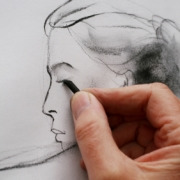
Tips to help you breeze through art school applications.
Applying to art school might sound like it requires a lot more work than applying to a liberal arts college. Yet art schools come in a variety of forms — and so do their applications.
No matter what type of art institution you’re aiming for, art school applications all share a few things in common. You’ll need letters of recommendation, a high school diploma, and (of course) artistic talent. Here are five things you’ll encounter on every art-centered application.
1. There’s a difference between “art school” and schools with art programs.
Art enthusiasts have multiple options when it comes to choosing a school. You can opt for a college that has an art department, a university that has it’s own art school, or an institution dedicated solely to art.
Almost every college has some kind of art department where students can earn a BFA (Bachelor of Fine Arts) in a variety of mediums. If you apply to universities that have separate art schools or standalone art institutions, you will also earn a BFA — but there will be more of a school-wide focus on art. For example, if you attend Brown University as a visual art major, you will also have to take a number of classes that have very little to do with art. But if you attend the Rhode Island School of Design, every class will involve art in some way.
2. Grades and SAT scores still matter.
If you thought applying to art school meant you could forget about your GPA, SAT, or ACT, think again. Art schools want to know that their students are serious about education. By looking at your grades, colleges can tell what kind of student you’ll be if you attend their school. Even the best portfolio can’t win over an admissions committee if the student’s grades are sub-par.
Perhaps most importantly, grades and test scores determine which students receive scholarships. Good grades and high scores can win you a lot of scholarship money.
3. Every — and we mean every — application requires a portfolio.
Your portfolio is a crucial part of your art school applications no matter where you apply. Whether you’re applying to USC or RISD, you’ll be asked to send in about 10 to 20 pieces of artwork. Schools expect you to have a body of work that shows what you’re capable of creating. Put your best artwork in your portfolio. It’s also a good idea to include a variety of pieces in your portfolio.
Additionally, each college will have its own requirements for what should go in your portfolio. Don’t forget to check their websites for an exact list; a one-size-fits-all portfolio won’t make the cut at most schools.
4. Interviews are crucial
Many colleges and universities recommend that applicants schedule in-person interviews. Talking with a school representative one-on-one allows the admissions office to see what students are like in person, and it helps give your application a face.
When it comes to art schools, interviews are especially important. Some schools even require them. Colleges want to see your dedication to art and education in person, and it’s a great way for them to hear you talk about your work. Interviewing at a school also benefits you. It allows you to ask questions and explain your creative process. You might even hear valuable portfolio feedback.
5. You’ll need to explain yourself.
Art often speaks for the artist who created it — after all, art is expression. However, art schools still expect their applicants to explain themselves using ink, paper, and complete sentences. As you fill out your applications, expect schools to ask questions about your educational and artistic goals. You’ll be asked to discuss your favorite artists, what inspires you, and why you’re interested in furthering your art education. You might even come across typical college essay questions like “Why are you interested in attending this school?” or “How do you plan to pursue your academic goals at our college?” If you respond with honest, genuine answers, colleges will have no problem seeing what makes you unique.
Art School Application: Quick Tips
- Unsure if your portfolio is ready to impress? You can ask art professors to share their feedback with you while touring campuses.
- Even artists can’t escape the personal statement — be prepared to write one for your art school applications.
- Some art schools use the Common Application but require a supplement as well. Don’t forget to read the fine print so you don’t leave out any important application material.